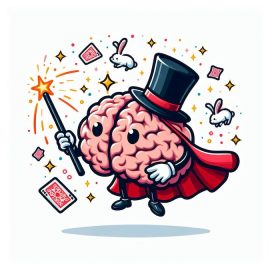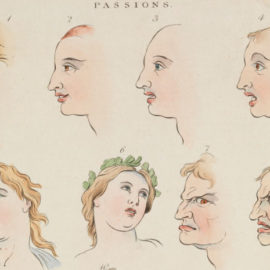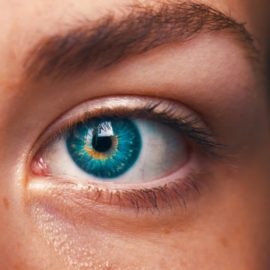

This article gives you a glimpse of what you can learn with Shortform. Shortform has the world’s best guides to 1000+ nonfiction books, plus other resources to help you accelerate your learning.
Want to learn faster and get smarter? Sign up for a free trial here .
Are you having trouble managing ADHD symptoms? What are some strategies to help you live with ADHD?
Attention deficit hyperactivity disorder (ADHD) is a brain condition that affects how you focus and control impulsive behavior. While ADHD can’t be cured, there are ways to help alleviate the symptoms so you can live an efficient and organized life.
Keep reading to learn how to live with ADHD.
What Is ADHD?
ADHD is a neurobiological condition that impairs working memory and executive function, among other things. Working memory is the capacity to hold information in our brains for immediate use in the short term, such as remembering what you need to retrieve when you walk into another room. Executive functioning refers to a set of skills related to planning ahead and making decisions. Everyone struggles with working memory and executive function from time to time, but, for people with ADHD, these deficits occur at a severity and frequency that substantially interferes with their daily lives.
According to Order From Chaos by Jaclyn Paul, ADHD can cause you to be constantly distracted by both your own thoughts and your environment. It can also cause you to make impulsive decisions, struggle to stop a task once you’ve begun it, and have difficulty conforming to common organizational methods. These and other traits can make you disorganized, and being disorganized can then make your symptoms worse, creating a negative cycle.
What’s more, ADHD can have negative impacts on your personal, professional, and social life. People often view ADHDers as lazy and irresponsible, but their behavior is the result of actual differences in their brains, not the result of a character flaw. These differences make certain aspects of life that are easy for most people nearly impossible for ADHDers.
As you work to get more organized, it’s important to avoid judging yourself for the things you struggle with any more than you would with a physical ailment. Just like you wouldn’t judge a person with epilepsy for taking medication or needing to avoid flashing lights, you shouldn’t judge yourself or other ADHDers for the way their atypical brains affect them.
How to Live With ADHD
Now that you know how ADHD affects people, it’s time to figure out how to manage it. Let’s look at four strategies for how to live with ADHD and not let the symptoms control you.
1. Find Out How ADHD Affects You
According to Paul, every person with ADHD is different, and their ADHD affects them differently. You have to form an understanding of how your ADHD affects you personally in order to devise the best system to manage it.
Understand Your Purpose
An essential part of Paul’s recommendations for living with ADHD is to identify the reason you want to get organized and keep that front of mind as you begin implementing her tips. Staying motivated is particularly difficult for people living with ADHD, so you’ll need to have a purpose for organizing that you can come back to any time it starts to feel too difficult. This purpose should be unique to you and related to the values that are important to you. It also can’t stem from the belief that you should be able to do something. That comes from a place of judgment and external pressure, and your purpose needs to provide you with internal motivation. Your purpose should help you nurture your genuine self so you can live the life you want to live.
Understand Your Limitations
Another part of getting to know yourself is understanding your capabilities and limitations. Living with ADHD becomes much easier when you only have to organize a manageable number of items. This means you need to be able to say no to people and commitments, let go of things in your life that don’t serve your purpose, and use only as much physical space and belongings as you can reasonably manage.
Paul explains that ADHD brains have less dopamine—the neurotransmitter that drives the body’s reward system—available to them. This means ADHDers seek stimulation and novelty, which can lead them to take on more obligations and commitments than they can handle. While it may be frustrating to accept, sometimes you need to demand less of yourself so you can consistently meet expectations. You may simply have a lower threshold for what you can reasonably take on than someone without ADHD.
Understand Your Scheduling Needs
Finally, identify your ideal daily schedule based on your energy and focus levels, writes Paul. Do you function best when you go to bed early and get up early, or are you more productive when you stay up later and sleep in? What types of work are easiest for you to complete at various times of the day? You may want to reserve your physical organization tasks for the time of day when you have the most energy and do the ones that require little thought for the time of day when you may have less mental energy.
2. Nurture Your Psychological and Physical Health
Since ADHD results from the underdevelopment of your brain and psyche in early childhood, Scattered Minds by Gabor Maté theorizes that you can heal your ADHD when you’re older by leveraging brain plasticity—your brain’s ongoing reactivity to environmental stimuli—to your advantage. According to Maté, there are two essential components to learning how to live with ADHD: pursuing psychological growth and physical self-nurturing.
Pursuing Psychological Growth
Accept yourself, including your difficult emotions and any behaviors you engage in but don’t necessarily approve of. Many people with ADHD struggle with self-esteem because they feel their condition holds them back from achieving their goals and getting others’ approval. You may even feel like there’s something innately wrong with you, which Maté attributes to the shame you felt every time the bond between you and your parents was ruptured. To gain self-acceptance, remind yourself that you’re doing your best and that healing is a journey—it’s okay if you’re not where you’d like to be yet.
Attend therapy. Maté explains that people have a deep-seated psychological need for validation from others, especially when they’re in pain. He says that a family therapist can provide you with that validation, help you understand your emotional pain, and support you in learning new psychological skills that can help you thrive.
Practice mindfulness. According to Maté, mindfulness improves your neurological capacity to focus; in addition, it may have other psychological benefits, like spiritual fulfillment, that help you heal the emotional pain that underlies your ADHD. He specifically recommends mindfulness meditation but notes that mindfulness can be incorporated into a vast array of activities, like spending time in nature.
Prioritize restorative recreation. Many people with ADHD overwork themselves as an outlet for their hyperactivity, but Maté says that, in the long run, this only increases your stress. Instead, you should give yourself time to play, explore, and rest. For example, you might take up a creative hobby like crochet.
Physical Self-Nurturing
If you struggle with addiction to any substance or behavior (as many people with ADHD do), seek treatment. According to Maté, to effectively treat addiction, you have to understand and deal with the root of the problem—the emotional pain you’re trying to cover up by engaging in your addictive behavior.
Keep a neat home. An untidy environment can add to your emotional stress. If you struggle with this, Maté recommends setting a timer for a short period of time and cleaning until it goes off. Over time, you’ll make steady progress toward maintaining your environment.
3. Get Enough Sleep
According to clinical expert Dave Anderson, children who live with ADHD struggle to sleep well. In turn, insufficient sleep can aggravate ADHD symptoms.
Why We Sleep by Matthew Walker suggests the following actions for getting enough sleep:
- Keep the same waking and sleeping time each day. Erratic sleep schedules disrupt sleep quality.
- Practice sleep hygiene—lower your bedroom’s temperature, reduce noise, and reduce light.
- No alcohol, caffeine, exercise, or long naps before sleep.
- Get some exercise, which may increase total sleep time and increase the quality of sleep. Exercising has more of a chronic effect, meaning it helps in the long run and doesn’t take effect on a day-to-day scale—exercise on one day doesn’t necessarily lead to better sleep that night. But, worse sleep on one night does lead to worse exercise the following day.
- Eat a normal diet (not a severe caloric restriction of below 800 calories per day). Avoid very high-carb diets (>70% of calories) since this increases awakenings.
- Avoid sleeping pills—they’re no better than a placebo.
- For those with insomnia, try cognitive behavioral therapy, which has been shown to be more effective than sleeping pills.
4. Organize Your Stuff
According to Order From Chaos, ADHDers can become disorganized more easily because they tend to quickly be overwhelmed by new input. We’re all constantly receiving various types of input. Much of it is informational like ideas and obligations, and much of it is physical like mail and belongings. For people who live with ADHD, the overwhelm from all this input often leads to disorganization of physical and digital items. By implementing organizational strategies and systems, ADHDers can gain better control over their lives and find greater peace.
In The Organized Mind, Daniel J. Levitin suggests that you use the power of externalization and sorting to track your things—and thus free up more mental energy to focus on other tasks and make better decisions. His strategies can help people who live with ADHD.
Levitin suggests that, when thinking about how to keep track of your stuff, there is a neurological trait—in addition to your brain’s tendency to sort—that you should keep in mind: You’re great at remembering where things are. This is because you have an entire brain region devoted to doing so: your hippocampus, which evolved to remember where important things (like the nearest source of fresh water) were in a pre-map era.
So, how can you work with your biology to organize your physical objects? Levitin names two strategies.
1) Designate a place for everything. Thanks to your fantastic spatial memory, you’re more likely to lose things that move rather than things that don’t; for example, you likely often lose your phone but never the clock on your bedside table. When designating these spaces, take advantage of categories: You don’t need to know where every fork you own is as long as you know where all the silverware is. And, if you own things that move regularly, either buy duplicates (if that’s feasible) or assign them a place to live. For example, if you regularly carry your laptop around your house, always return it to your desk when you stop using it.
If you have no idea where to put something, or you’re just not sure where it goes yet, Levitin suggests having a junk drawer or a miscellaneous file. You’ll inevitably encounter things you don’t know what to do with and that don’t warrant a single place; for example, you probably don’t want to designate an entire drawer just for matches. Placing these items in a junk drawer will save you time and energy as you build your organized system.
2) Adjust the environment so that it reminds you what to do. This can be built into the organization system you select; for example, you might purchase a silverware organizer that’s labeled with a picture on each slot that denotes which utensils go there.
Alternatively, you can temporarily change the environment based on your needs—which will help you remember where something is because your attentional filter will pick up on it. For example, if you want to remember to send a letter, put it in front of the coffeemaker so that you’ll see it in the morning. However, remember that this works only because it’s unusual; if your mail usually lives by the coffeemaker, or if you forget to take the mail out and leave it there for a week, you’ll stop noticing it because your attentional filter will get used to it and thus ignore it.
How to Organize Your Digital Information
You’ve learned how to organize your physical objects—but how should you deal with the digital spaces in your life?
Just as with real-life spaces, Levitin suggests that you take advantage of your spatial memory when organizing digital information by designating different virtual spaces for specific tasks. You can do so either by purchasing separate devices or by visually altering the same device to trick your brain. For example, you could purchase one computer for work and another for personal tasks, or you could create two separate users on the same computer for your “work self” and “personal self” and place different desktop backgrounds on each account. Then, when you need to find something (like a receipt), you’ll know where to look based on whether it was for business or pleasure.
Levitin adds that, if you’re using your computer to track important files, you should sort them by type. This allows you to easily find your file on the computer even if you don’t remember the exact file name. To sort your files, consider what higher-order group each file might fall into, then separate them into folders accordingly. Levitin recommends that you have no more than 30 files in each folder. And, when creating these files and folders, think about how you’ll eventually look for them to make these classifications easier. For example, if you tend to remember when you did something, subdivide your “Business Receipts” folder by date; if you tend to remember what you paid for, sort them by task (like “lunch receipts” or “utilities receipts”).
Final Words
Living with ADHD can be stressful if you don’t know how to manage it. It’s a complex disorder that affects everyone differently, and you might feel frustrated that some solutions like medication or counseling don’t work for you. Perhaps the above strategies can finally help you figure out how to live with ADHD and struggle less with the symptoms.
What are other ways to help people learn how to live with ADHD? Let us know in the comments below!

Want to fast-track your learning? With Shortform, you’ll gain insights you won't find anywhere else .
Here's what you’ll get when you sign up for Shortform :
- Complicated ideas explained in simple and concise ways
- Smart analysis that connects what you’re reading to other key concepts
- Writing with zero fluff because we know how important your time is






